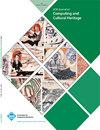A Low-Cost Method and Surveying of the Historical Structures from Digital Resources
IF 2.2
3区 计算机科学
Q3 COMPUTER SCIENCE, INTERDISCIPLINARY APPLICATIONS
引用次数: 0
Abstract
A new method using optics in non-contact photogrammetry to find the dimensions of target objects by digital archive and/or open source digital images has been presented in this paper. In the proposed method a reference object of known dimension must be present in the field of view of pair of images collected at any two unknown arbitrary positions along the axis of camera (z-axis) and 2D size measurement (x-y) of other target objects is done successfully with the help of the proposed algorithm. The presented method is applicable to the number of images(>=2) containing the target objects and reference object which are not in the same plane and which may be shot from any camera not known to user and hence the internal and external specifications of the camera are completely unknown to the user. The method has been verified successfully to show its applicability in low-cost surveys by determining the dimensions of Washington-Monument, Christ the Redeemer (Rio De Janerio) and Eiffel Tower (Paris) from open source images. Further an example case of Notre-Dame Cathedral is demonstrated to find the size of the destroyed Spire from the undestroyed reference structure. The results are being compared with known standard values of structures and the relative error percentage for all the cases using the proposed algorithm are found to be less than 1%. The method may find applications in survey or analysis by old digital video footages or images from archive/libraries where the camera specifications are not known to the user.数字资源历史建筑的低成本方法与测量
本文提出了一种利用光学技术在非接触摄影测量中利用数字存档和/或开源数字图像求出目标物体尺寸的新方法。该方法沿相机轴线(z轴)在任意两个未知位置采集的图像对的视场内必须存在已知尺寸的参考物体,并利用该算法成功地完成了其他目标物体的二维尺寸测量(x-y)。所提出的方法适用于目标物体和参考物体不在同一平面的图像数量(>=2),这些图像可以从用户不知道的任何相机拍摄,因此用户完全不知道相机的内部和外部规格。通过从开源图像中确定华盛顿纪念碑、基督救世主(里约热内卢)和埃菲尔铁塔(巴黎)的尺寸,成功验证了该方法在低成本调查中的适用性。此外,还以巴黎圣母院为例,从未被破坏的参考结构中找到被破坏的尖顶的大小。将计算结果与已知的结构标准值进行了比较,发现使用该算法的所有情况的相对误差百分比都小于1%。该方法可用于调查或分析来自档案/图书馆的旧数字视频片段或图像,而用户不知道相机规格。
本文章由计算机程序翻译,如有差异,请以英文原文为准。
求助全文
约1分钟内获得全文
求助全文
来源期刊

ACM Journal on Computing and Cultural Heritage
Arts and Humanities-Conservation
CiteScore
4.60
自引率
8.30%
发文量
90
期刊介绍:
ACM Journal on Computing and Cultural Heritage (JOCCH) publishes papers of significant and lasting value in all areas relating to the use of information and communication technologies (ICT) in support of Cultural Heritage. The journal encourages the submission of manuscripts that demonstrate innovative use of technology for the discovery, analysis, interpretation and presentation of cultural material, as well as manuscripts that illustrate applications in the Cultural Heritage sector that challenge the computational technologies and suggest new research opportunities in computer science.
 求助内容:
求助内容: 应助结果提醒方式:
应助结果提醒方式:


